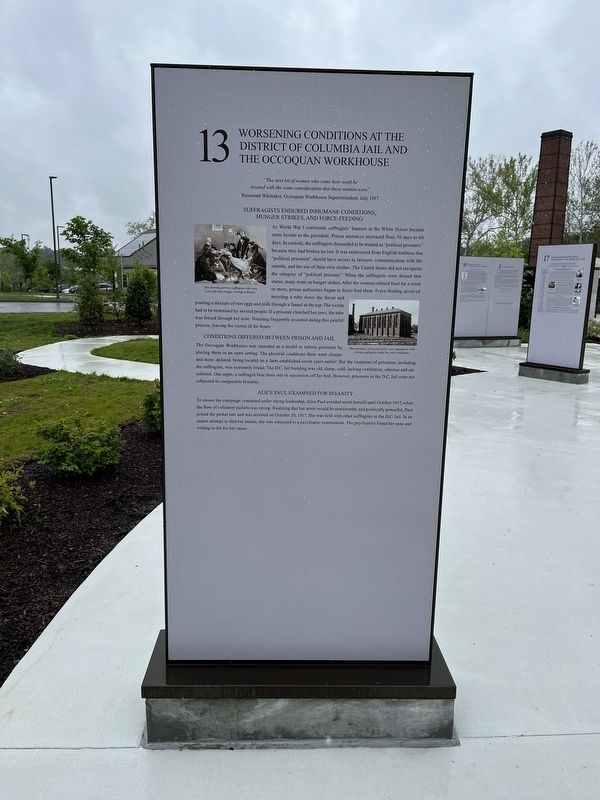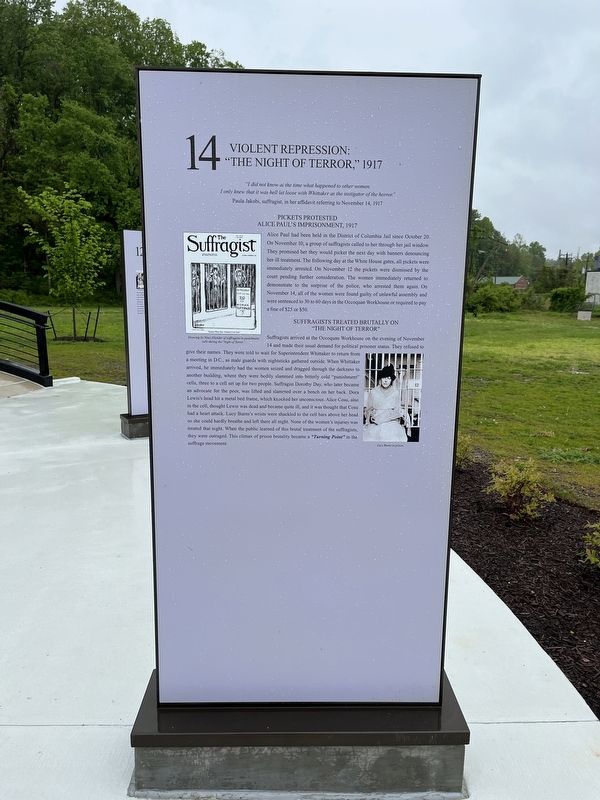Lorton in Fairfax County, Virginia — The American South (Mid-Atlantic)
Worsening Conditions / Violent Repression
Worsening Conditions at the District of Columbia Jail and the Occoquan Workhouse
"The next lot of women who come here won't be treated with the same consideration that these women were."
Raymond Whittaker, Occoquan Workhouse Superintendent, July 1917
Suffragists Endured Inhumane Conditions, Hunger Strikes, and Force-Feeding
As World War I continued, suffragists' banners at the White House became more hostile to the president. Prison sentences increased from 30 days to 60 days. In custody, the suffragists demanded to be treated as "political prisoners" because they had broken no law. It was understood from English tradition that "political prisoners" should have access to lawyers, communication with the outside, and the use of their own clothes. The United States did not recognize the category of "political prisoner." When the suffragists were denied that status, many went on hunger strikes. After the women refused food for a week or more, prison authorities began to force-feed them. Force-feeding involved inserting a tube down the throat and pouring a mixture of raw eggs and milk through a funnel at the top. The victim had to be restrained by several people. If a prisoner clenched her jaws, the tube was forced through her nose. Vomiting frequently occurred during this painful process, leaving the victim ill for hours.
Conditions Differed Between Prison and Jail
The Occoquan Workhouse was intended as a model to reform prisoners by placing them in an open setting. The physical conditions there were cleaner and more updated, being located on a farm established seven years earlier. But the treatment of prisoners, including the suffragists, was extremely brutal. The D.C. Jail building was old, damp, cold, lacking ventilation, odorous and rat-infested. One night, a suffragist beat three rats in a succession off her bed. However, prisoners in the D.C. Jail were not subjected to comparable brutality.
Alice Paul Examined for Insanity
To ensure the campaign continued under strong leadership, Alice Paul avoided arrest herself until October 1917, when the flow of volunteer pickets was strong. Realizing that her arrest would be newsworthy and politically powerful, Paul joined the picket line and was arrested on October 20, 1917. She was held with other suffragists in the D.C. Jail In an unjust attempt to find her insane, she was subjected to a psychiatric examination. The psychiatrist found her sane and willing to die for her cause.
Violent Repression: "The Night of Terror," 1917
"I did not know at the time what happened to the other women. I only knew that it washell let loose with Whittaker as the instigator of the horror."
Paula Jakobi, suffragist, in her affidavit referring to November 14, 1917
Pickets Protested Alice Paul's Imprisonment, 1917
Alice Paul had been held in the District of Columbia Jail since October 20. On November 10, a group of suffragists called to her through her jail window. They promised her they would picket the next day with banners denouncing her ill treatment. The following day at the White House gates, all pickets were immediately arrested. On November 12 the pickets were dismissed by the court pending further consideration. The women immediately returned to demonstrate to the surprise of the police, who arrested them again. On November 14, all of the women were found guilty of unlawful assembly and were sentenced to 30 to 60 days in the Occoquan Workhouse or required to pay a fine of $25 or $50.
Suffragists Treated Brutally on "The Night of Terror"
Suffragists arrived at the Occoquan Workhouse on the evening of November 14 and made their usual demand for political prisoner status. They refused to give their names. They were told to wait for Superintendent Whittaker to return from a meeting in D.C., as male guards with nightsticks gathered outside. When Whittaker arrived, he immediately had the women seized and dragged through the darkness to another

Photographed By Devry Becker Jones (CC0), May 6, 2022
3. The second half of the displays can be seen here.
Erected 2021 by Turning Point Suffragist Memorial Association. (Marker Number 13/14.)
Topics and series. This historical marker is listed in these topic lists: Animals • Civil Rights • Law Enforcement • Notable Events • Science & Medicine • Women. In addition, it is included in the Former U.S. Presidents: #28 Woodrow Wilson series list. A significant historical month for this entry is July 1917.
Location. 38° 40.933′ N, 77° 15.166′ W. Marker is in Lorton, Virginia, in Fairfax County. Marker is on Lorton Road, one mile south of Ox Road (Virginia Route 123), on the left when traveling east. Touch for map. Marker is at or near this postal address: 9751 Ox Rd, Lorton VA 22079, United States of America. Touch for directions.
Other nearby markers. At least 8 other markers are within walking distance of this marker. The Suffrage Campaign in Wartime / Suffrage Pickets Chose Prison (here, next to this marker); Victories in 1917 / Suffragists Demonstrated Until Congress Passed the 19th Amendment (here, next to this marker); Hard-Fought Ratification Campaigns in the States / The Continued Struggle for Voting Rights (a few steps from this marker); "Forward Into Light," Toward Equality, 1920 - Present / The 19th Amendment (a few steps from this marker); 1916 / Nonviolent Protests at the White House Gates (a few steps from this marker); "Forward Out of Darkness" / Issuing a Call for Women's Rights (a few steps from this marker); New Life in State by State Campaigns / The 1913 Suffrage Parade Captured National Attention (a few steps from this marker); Building a Political Movement / Testing Constitutional Amendments (a few steps from this marker). Touch for a list and map of all markers in Lorton.
Additional commentary.
1. Titles for the marker
Unfortunately, the titles on both sides of this marker are too long to fit on the main title line. The title on the front side was truncated to fit the tiles of both sides onto the marker's profile.
The entire title for each side is shared in the marker details.
— Submitted May 7, 2022, by Devry Becker Jones of Washington, District of Columbia.
Additional keywords. human rights violations; medical ethics violations; torture
Credits. This page was last revised on November 6, 2023. It was originally submitted on May 7, 2022, by Devry Becker Jones of Washington, District of Columbia. This page has been viewed 86 times since then and 11 times this year. Photos: 1, 2, 3. submitted on May 7, 2022, by Devry Becker Jones of Washington, District of Columbia.

